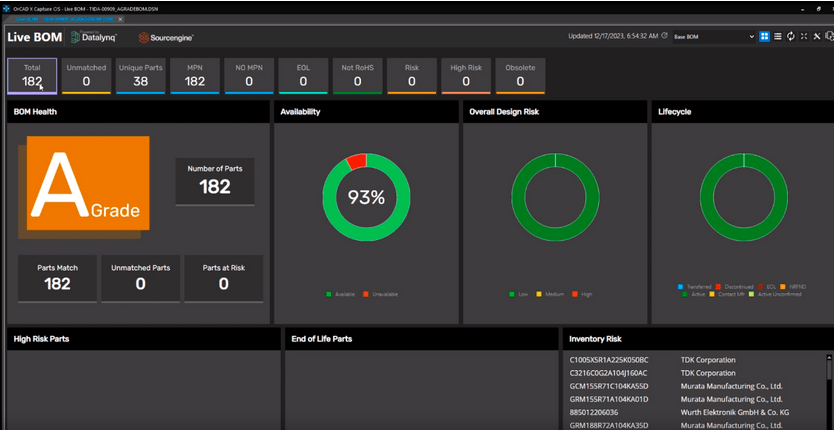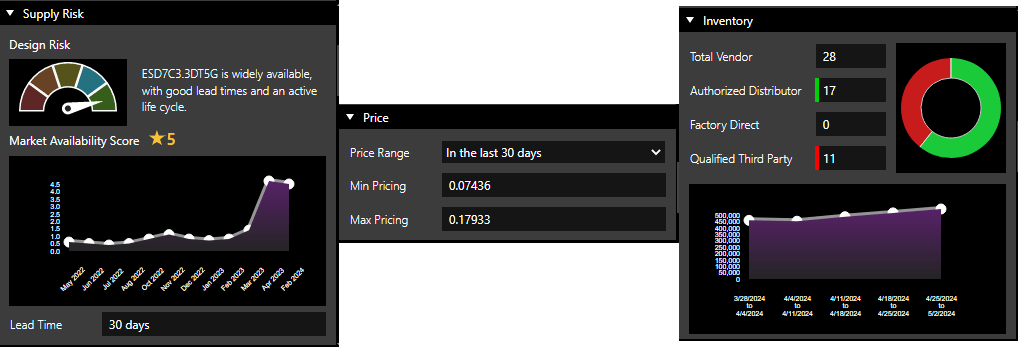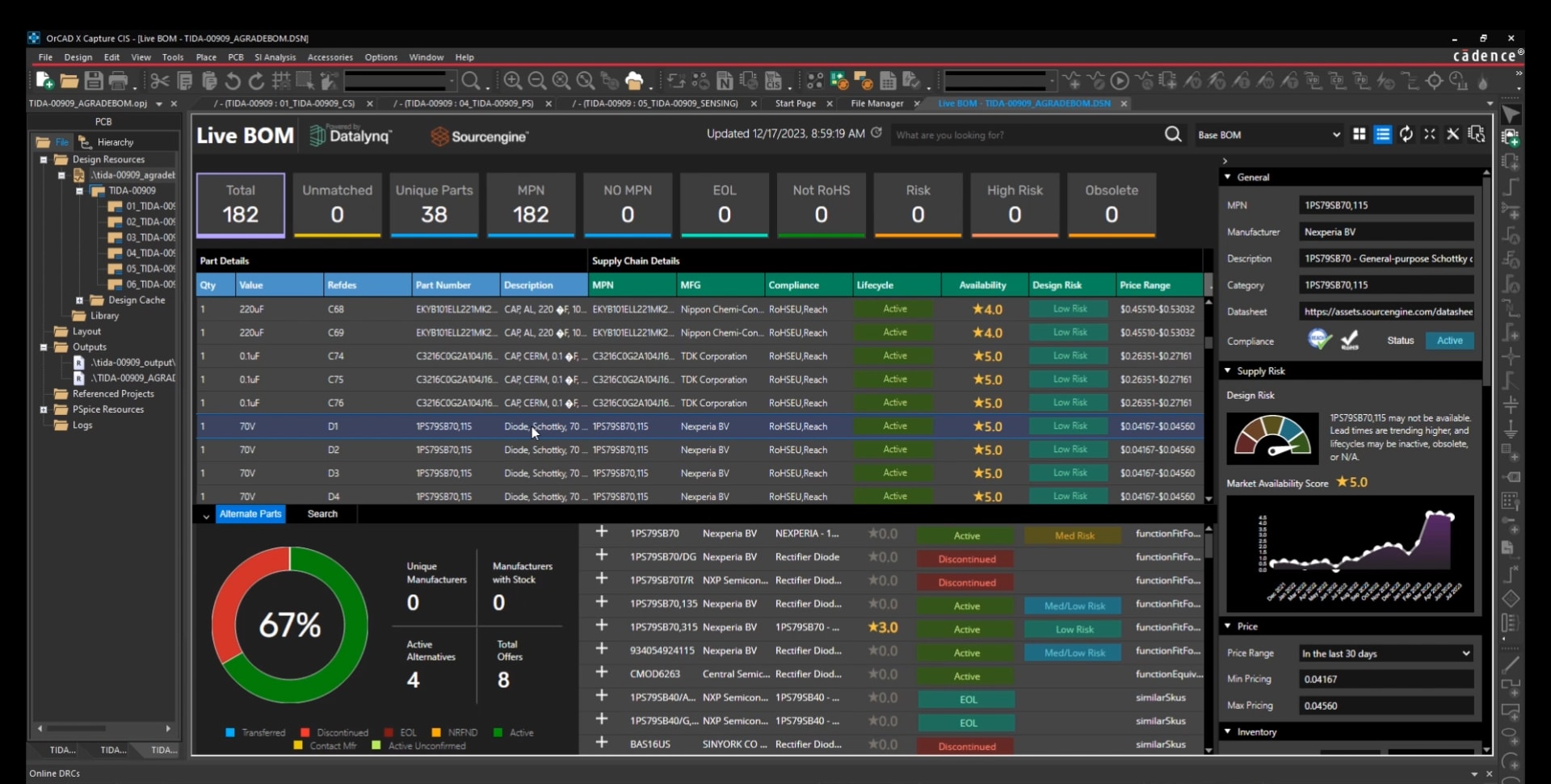Identify Electronic Component Availability With OrCAD X
Key Takeaways
-
Electronic component availability is a product of the manufacturer's supply, which can vary due to market forces and the manufacturer’s commitment to replacement product lines.
-
Designers will have to determine replacement components as components enter obsolescence and end-of-life production.
-
OrCAD X and Live BOM make it easy to evaluate the total BOM’s risk profile and identify individual MPN replacements.

A large part of the BOM Health grade in Live BOM comes from electronic component availability.
Working through electronic component procurement is, at least initially, like going grocery shopping for an unfinalized recipe: while the broad strokes of the final product are known, availability, cost, package size/style, and additional physical factors may make specific components more or less viable for the design goal. Gathering more components than necessary is an option (especially if design variants are present and active), but this can be financially infeasible for smaller teams with limited budgets or vast production quantities. Time-to-market deadlines can also be a potent impetus, and electronic component availability can be the difference between meeting production benchmarks and missing crucial windows. OrCAD X users can rely on the up-to-the-moment market updates from a leading component database to guide their BOM and design.
What Influences Electronic Component Availability?
|
Supply/Demand |
Ubiquitous components are more likely to have greater supply (though these can be more susceptible to runs on supply). |
|
Production Lifecycle |
Newer components and those in EOL production can be challenging to source reliably. Conversely, product lines well into the “mid-life” of production are most available and among the lifecycle's cheapest price points. |
|
Manufacturer Preference |
Production lines generally see shorter lifecycles to support the introduction of improved or replacement chips. |
Electronic Component Availability and Production Knock-On Effects
Electronics development must consider assembly logistics before embarking on production or even getting deep into the design phase. Cost is usually the paramount driver for obvious reasons, but a lesser heralded (indeed, an input variable for the cost) is the availability of these components. Nowhere was this more visible than during a manufacturing slowdown/shutdown during a global pandemic response that choked supplies so much that ramifications are still present years later. While efforts are ongoing to address these supply chain vulnerabilities in the long term, the current market conditions dictate deft maneuvering by procurement teams to meet these BOM requirements.
Component procurement is the last thing on a designer's mind during the initial design planning. Consider that the schematic, simulations, and layout can all shift the project requirements while maintaining the design intent established at the outset, and the design scope may change by adding or removing features. Across multiple early iterations of prototypes and revisions, bulk component orders are unnecessary due to small production lot quantities whose primary purpose is to provide tangible in-circuit feedback and test results on the quality of the design. Yet procurement must execute orders well before this stage to account for common and specific components, with lead times stretching out for several months in some instances.
Lead times and cost are the most immediate effects of this manufacturing backlog. As manufacturers continue to address component supplies on backorder with new orders flowing in, some have implemented allocation measures to ensure they can fairly fulfill as many orders as reasonably possible. To procurement, this means maximums on bulk purchases that can stymy efforts and spread a single purchase across multiple manufacturers (each with independent costs, lead times, etc.) Coupled with purchase order minimums due to overwhelming demand and additional measures like order holds that restrict new purchases, procurement teams are facing an uphill road to sourcing components.
How OrCAD X and Live BOM Circumvent Availability Issues
Unfortunately, counterfeit component manufacturers and resellers are preying on supply chain frustrations and desperation. Mislabeled or otherwise fraudulent component specifications pose a significant performance and reliability issue. For designers, vigilance is necessary. With the heightened difficulty of securing authentic components during the aftershocks of a massive supply chain disruption, procurement has to thread the needle in the face of growing lead times.
The solution is dealing with trusted vendors – lots of them. With OrCAD X, Live BOM (powered by Sourcengine) contains information on billions of MPNs from thousands of reputable vendors and direct manufacturers and can fulfill orders in a few clicks of the dashboard, all without leaving the ECAD tool. Engaging with multiple vendors allows procurement teams to quickly compare availability, lead time, and cost for an optimal procurement solution; it’s easier than ever to gauge BOM optimization at a glance and improve design fitness by focusing on these three key elements. Rolling data trends also allow procurement to forecast future component availability to sidestep downstream production/sourcing issues.

Live BOM provides essential risk analysis, cost, and inventory data.
Additionally, Live BOM measures overall design risk by combining general availability with manufacturer production status for end-of-life (EOL) and obsolete components. From here, design teams can plot a course for component replacement (if necessary) with suggestions for equivalent, alternate, and drop-in replacements to minimize design rework in completed or ongoing layouts. With the tools above for market analysis, it’s easier than ever for designs to stand the test of time with OrCAD X and Live BOM.

Live BOM makes it easy to identify and source replacement components.
Cadence Software Solutions Offer Complete PCB Design Analysis
Electronic component availability is a challenging proposition for procurement teams that increases with the severity of the production quantity and lingering supply chain issues. Fortunately, OrCAD X and Live BOM make sourcing solutions more effortless than ever with up-to-the-minute supply, cost, and lead times updated directly from manufacturers. Looking to expand design manufacturability analysis and improve design outcomes? See a complete list of Cadence PCB Design and Analysis Software that helps bring modern electronic designs to life.
Leading electronics providers rely on Cadence products to optimize power, space, and energy needs for a wide variety of market applications. Talk to our team of experts or subscribe to our YouTube channel to learn more about our innovative solutions.